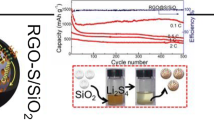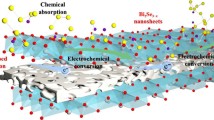Abstract
Although some experiments have shown that point defects in a cathode host material may enhance its performance for lithium-sulfur battery (LSB), the enhancement mechanism needs to be well investigated for the design of desired sulfur host. Herein, the first principle density functional theory (DFT) is adopted to investigate a high-performance sulfur host material based on oxygen-defective TiO2 (D-TiO2). The adsorption energy comparisons and Gibbs free energy analyses verify that D-TiO2 has relatively better performances than defect-free TiO2 in terms of anchoring effect and catalytic conversion of polysulfides. Meanwhile, D-TiO2 is capable of absorbing the most soluble and diffusive long-chain polysulfides. The newly designed D-TiO2 composited with three-dimensional graphene aerogel (D-TiO2@Gr) has been shown to be an excellent sulfur host, maintaining a specific discharge capacity of 1,049.3 mAhg−1 after 100 cycles at 1C with a sulfur loading of 3.2 mgcm−2. Even with the sulfur mass loading increasing to 13.7 mgcm−2, an impressive stable cycling is obtained with an initial areal capacity of 14.6 mAhcm−2, confirming the effective enhancement of electrochemical performance by the oxygen defects. The DFT calculations shed lights on the enhancement mechanism of the oxygen defects and provide some guidance for designing advanced sulfur host materials.

Similar content being viewed by others
References
Kim, H.; Lee, J.; Ahn, H.; Kim, O.; Park, M. J. Synthesis of three-dimensionally interconnected sulfur-rich polymers for cathode materials of high-rate lithium-sulfur batteries. Nat. Commun.2015, 6, 7278.
Manthiram, A.; Chung, S. H.; Zu, C. X. Lithium-sulfur batteries: Progress and prospects. Adv. Mater.2015, 27, 1980–2006.
Son, Y.; Lee, J. S.; Son, Y.; Jang, J. H.; Cho, J. Recent advances in lithium sulfide cathode materials and their use in lithium sulfur batteries. Adv. Energy Mater.2015, 5, 1500110.
Yang, Y.; Zheng, G. Y.; Cui, Y. Nanostructured sulfur cathodes. Chem. Soc. Rev.2013, 42, 3018–3032.
Guo, W.; Fu, Y. Z. A perspective on energy densities of rechargeable Li-S batteries and alternative sulfur-based cathode materials. Energy Environ. Mater.2018, 1, 20–27.
Yu, T.; Li, F.; Liu, C. Y.; Zhang, S. T.; Xu, H. Y.; Yang, G. C. Understanding the role of lithium sulfide clusters in lithium-sulfur batteries. J. Mater. Chem. A2017, 5, 9293–9298.
Xu, R.; Lu, J.; Amine, K. Progress in mechanistic understanding and characterization techniques of Li-S batteries. Adv. Energy Mater.2015, 5, 1500408.
He, Y. B.; Chang, Z.; Wu, S. C.; Zhou, H. S. Effective strategies for long-cycle life lithium-sulfur batteries. J. Mater. Chem. A2018, 6, 6155–6182.
Fu, A.; Wang, C. Z.; Pei, F.; Cui, J. Q.; Fang, X. L.; Zheng, N. F. Recent advances in hollow porous carbon materials for lithium-sulfur batteries. Small2019, 15, 1804786.
Ogoke, O.; Wu, G.; Wang, X. L.; Casimir, A.; Ma, L.; Wu, T. P.; Lu, J. Effective strategies for stabilizing sulfur for advanced lithium-sulfur batteries. J. Mater. Chem. A2017, 5, 448–469.
Pang, Q.; Liang, X.; Kwok, C. Y.; Nazar, L. F. Advances in lithium-sulfur batteries based on multifunctional cathodes and electrolytes. Nat. Energy2016, 1, 16132.
Wu, Y. L.; Zhu, X. R.; Li, P. R.; Zhang, T.; Li, M.; Deng, J.; Huang, Y.; Ding, P.; Wang, S. X.; Zhang, R. et al. Ultradispersed WxC nanoparticles enable fast polysulfide interconversion for high-performance Li-S batteries. Nano Energy2019, 59, 636–643.
Yu, M. L.; Zhou, S.; Wang, Z. Y.; Wang, Y. W.; Zhang, N.; Wang, S.; Zhao, J. J.; Qiu, J. S. Accelerating polysulfide redox conversion on bifunctional electrocatalytic electrode for stable Li-S batteries. Energy Storage Mater.2018, 20, 98–107.
Du, L. Y.; Wu, Q.; Yang, L. J.; Wang, X.; Che, R. C.; Lyu, Z.; Chen, W.; Wang, X. Z.; Hu, Z. Efficient synergism of electrocatalysis and physical confinement leading to durable high-power lithium-sulfur batteries. Nano Energy2019, 57, 34–40.
Xu, L. L.; Zhao, H. Y.; Sun, M. Z.; Huang, B. L.; Wang, J. W.; Xia, J. L.; Li, N.; Yin, D. D.; Luo, M.; Luo, F. et al. Oxygen vacancies on layered niobic acid that weaken the catalytic conversion of polysulfides in lithium-sulfur batteries. Angew Chem., Int. Ed.2019, 58, 11491–11496.
Yu, M. L.; Wang, Z. Y.; Wang, Y. W.; Dong, Y. F.; Qiu, J. S. Freestanding flexible Li2S paper electrode with high mass and capacity loading for high-energy Li-S batteries. Adv. Energy Mater.2017, 7, 1700018.
Peng, H. J.; Huang, J. Q.; Cheng, X. B.; Zhang, Q. Review on high-loading and high-energy lithium-sulfur batteries. Adv. Energy Mater.2017, 7, 1700260.
Yang, W.; Yang, W.; Dong, L. B.; Gao, X. C.; Wang, G X.; Shao, G. J. Enabling immobilization and conversion of polysulfides through a nitrogen-doped carbon nanotubes/ultrathin MoS2 nanosheet core-shell architecture for lithium-sulfur batteries. J. Mater. Chem. A2019, 7, 13103–13112.
Salhabi, E. H. M.; Zhao, J. L.; Wang, J. Y.; Yang, M.; Wang, B.; Wang, D. Hollow multi-shelled structural TiO2-x with multiple spatial confinement for long-life lithium-sulfur batteries. Angew. Chem., Int. Ed. 2019, 58, 9078–9082.
Wang, H. E.; Yin, K. L.; Qin, N.; Zhao, X.; Xia, F. J.; Hu, Z. Y.; Guo, G. L.; Cao, G. Z.; Zhang, W. J. Oxygen-deficient titanium dioxide as a functional host for lithium-sulfur batteries. J. Mater. Chem. A2019, 7, 10346–10353.
Cai, W. L.; Li, G. R.; Zhang, K. L.; Xiao, G. N.; Wang, C.; Ye, K. F.; Chen, Z. W.; Zhu, Y. C.; Qian, Y. T. Conductive nanocrystalline niobium carbide as high-efficiency polysulfides tamer for lithium-sulfur batteries. Adv. Funct. Mater.2018, 28, 1704865.
Hao, B. Y.; Li, H.; Lv, W.; Zhang, Y. B.; Niu, S. Z.; Qi, Q.; Xiao, S. J.; Li, J.; Kang, F. Y.; Yang, Q. H. Reviving catalytic activity of nitrides by the doping of the inert surface layer to promote polysulfide conversion in lithium-sulfur batteries. Nano Energy2019, 60, 305–311.
Li, C. C.; Liu, X. B.; Zhu, L.; Huang, R. Z.; Zhao, M. W.; Xu, L. Q.; Qian, Y. T. Conductive and polar titanium boride as a sulfur host for advanced lithium-sulfur batteries. Chem. Mater.2018, 30, 6969–6977.
Guan, B.; Fan, L. S.; Wu, X.; Wang, P. X.; Qiu, Y.; Wang, M. X.; Guo, Z. K.; Zhang, N. Q.; Sun, K. N. The facile synthesis and enhanced lithium-sulfur battery performance of an amorphous cobalt boride (Co2B)@graphene composite cathode. J. Mater. Chem. A2018, 6, 24045–24049.
Chen, Y.; Zhang, W. X.; Zhou, D.; Tian, H. J.; Su, D. W.; Wang, C. Y.; Stockdale, D.; Kang, F. Y.; Li, B. H.; Wang, G. X. Co-Fe mixed metal phosphide nanocubes with highly interconnected-pore architecture as an efficient polysulfide mediator for lithium-sulfur batteries. ACS Nano2019, 13, 4731–4741.
Razaq, R.; Sun, D.; Xin, Y.; Li, Q.; Huang, T. Z.; Zheng, L.; Zhang, Z. L.; Huang, Y. H. Enhanced kinetics of polysulfide redox reactions on Mo2C/CNT in lithium-sulfur batteries. Nanotechnology2018, 29, 295401.
Wang, J. W.; Zhou, B.; Zhao, H. Y.; Wu, M. M.; Yang, Y. D.; Sun, X. L.; Wang, D. H.; Du, Y. P. A sandwich-type sulfur cathode based on multifunctional ceria hollow spheres for high-performance lithium-sulfur batteries. Mater. Chem. Front.2019, 3, 1317–1322.
Zhou, T. H.; Lv, W.; Li, J.; Zhou, G. M.; Zhao, Y.; Fan, S. X.; Liu, B. L.; Li, B. H.; Kang, F. Y.; Yang, Q. H. Twinborn TiO2-TiN heterostructures enabling smooth trapping-diffusion-conversion of polysulfides towards ultralong life lithium-sulfur batteries. Energy Environ. Sci.2017, 10, 1694–1703.
Song, Y. Z.; Zhao, W.; Kong, L.; Zhang, L.; Zhu, X. Y.; Shao, Y. L.; Ding, F.; Zhang, Q.; Sun, J. Y.; Liu, Z. F. Synchronous immobilization and conversion of polysulfides on a VO2-VN binary host targeting high sulfur load Li-S batteries. Energy Environ. Sci.2018, 11, 2620–2630.
Choudhury, B.; Bayan, S.; Choudhury, A.; Chakraborty, P. Narrowing of band gap and effective charge carrier separation in oxygen deficient TiO2 nanotubes with improved visible light photocatalytic activity. J. Colloid Interf. Sci2016, 465, 1–10.
Liu, M. M; Zhang, C. C.; Su, J. M.; Chen, X.; Ma, T. Y.; Huang, T.; Yu, A. S. Propelling polysulfide conversion by defect-rich MoS2 nanosheets for high-performance lithium-sulfur batteries. ACS Appl. Mater. Interfaces2019, 11, 20788–20795.
Tian, Y.; Zhao, Y.; Zhang, Y. G.; Ricardez-Sandoval, L. A.; Wang, X.; Li, J. D. Construction of oxygen-deficient La(OH)3 nanorods wrapped by reduced graphene oxide for polysulfide trapping toward high-performance lithium/sulfur batteries. ACS Appl. Mater. Interfaces2019, 11, 23271–23279.
Wang, Y. K.; Zhang, R. F.; Chen, J.; Wu, H.; Lu, S. Y.; Wang, K.; Li, H. L.; Harris, C. J.; Xi, K.; Kumar, R. V. et al. Enhancing catalytic activity of titanium oxide in lithium-sulfur batteries by band engineering. Adv. Energy Mater.2019, 9, 1900953.
Chen, X.; Hou, T. Z.; Persson, K. A.; Zhang, Q. Combining theory and experiment in lithium-sulfur batteries: Current progress and future perspectives. Mater. Today2019, 22, 142–158.
Rana, M.; Li, M.; Huang, X.; Luo, B.; Gentle, I.; Knibbe, R. Recent advances in separators to mitigate technical challenges associated with re-chargeable lithium sulfur batteries. J. Mater. Chem. A2019, 7, 6596–6615.
Hummers, W. S. Jr., Offeman, R. E. Preparation of graphitic oxide. J. Am. Chem. Soc.1958, 80, 1339.
Wan, J. W.; Chen, W. X.; Jia, C. Y.; Zheng, L. R.; Dong, J. C.; Zheng, X. S.; Wang, Y.; Yan, W. S.; Chen, C.; Peng, Q. et al. Defect effects on TiO2 nanosheets: Stabilizing single atomic site Au and promoting catalytic properties. Adv. Mater.2018, 30, 1705369.
Kresse, G.; Furthmüller, J. Efficient iterative schemes for ab initio total-energy calculations using a plane-wave basis set. Phys. Rev. B1996, 54, 11169–11186.
Perdew, J. P.; Burke, K.; Ernzerhof, M. Generalized gradient approximation made simple. Phys. Rev. Lett.1996, 77, 3865–3868.
Kresse, G.; Joubert, D. From ultrasoft pseudopotentials to the projector augmented-wave method. Phys. Rev. B1999, 59, 1758–1775.
Grimme, S.; Antony, J.; Ehrlich, S.; Krieg, H. A consistent and accurate ab initio parametrization of density functional dispersion correction (DFT-D) for the 94 elements H-Pu. J. Chem. Phys.2010, 132, 154104.
Henkelman, G.; Uberuaga, B. P.; Jónsson, H. A climbing image nudged elastic band method for finding saddle points and minimum energy paths. J. Chem. Phys.2000, 113, 9901–9904.
Savva, A. I.; Smith, K. A.; Lawson, M.; Croft, S. R.; Weltner, A. E.; Jones, C. D.; Bull, H.; Simmonds, P. J.; Li, L.; Xiong, H. Defect generation in TiO2 nanotube anodes via heat treatment in various atmospheres for lithium-ion batteries. Phys. Chem. Chem. Phys.2018, 20, 22537–22546.
Sarkar, A.; Khan, G. G. The formation and detection techniques of oxygen vacancies in titanium oxide-based nanostructures. Nanoscale2019, 11, 3414–3444.
Li, B. Q.; Peng, H. J.; Chen, X.; Zhang, S. Y.; Xie, J.; Zhao, C. X.; Zhang, Q. Polysulfide electrocatalysis on framework porphyrin in high-capacity and high-stable lithium-sulfur batteries. CCS Chem.2019, 1, 128–137.
Gao, X. J.; Yang, X. F.; Li, M. S.; Sun, Q.; Liang, J. N.; Luo, J.; Wang, J. W.; Li, W. H.; Liang, J. W.; Liu, Y. L. et al. Cobalt-doped SnS2 with dual active centers of synergistic absorption-catalysis effect for high-S loading Li-S batteries. Adv. Funct. Mater.2019, 29, 1806724.
Cai, D.; Lu, M. J.; Li, L.; Cao, J. M.; Chen, D.; Tu, H. R.; Li, J. Z.; Han, W. A highly conductive MOF of graphene analogue Ni3(HITP)2 as a sulfur host for high-performance lithium-sulfur batteries. Small2019, 15, 1902605.
Liu, S. F.; Ji, X.; Yue, J.; Hou, S.; Wang, P. F.; Cui, C. Y.; Chen, J.; Shao, B. W.; Li, J. R.; Han, F. D. et al. High interfacial-energy interphase promoting safe lithium metal batteries. J. Am. Chem. Soc.2020, 142, 2438–2447.
Acknowledgements
This work was supported by the Excellent Dissertation Cultivation Funds of Wuhan University of Technology (No. 2018-YS-013).
Author information
Authors and Affiliations
Corresponding author
Electronic Supplementary Material
12274_2020_2850_MOESM1_ESM.pdf
Oxygen defects boost polysulfides immobilization and catalytic conversion: First-principles computational characterization and experimental design
Rights and permissions
About this article
Cite this article
He, Q., Yu, B., Wang, H. et al. Oxygen defects boost polysulfides immobilization and catalytic conversion: First-principles computational characterization and experimental design. Nano Res. 13, 2299–2307 (2020). https://doi.org/10.1007/s12274-020-2850-5
Received:
Revised:
Accepted:
Published:
Issue Date:
DOI: https://doi.org/10.1007/s12274-020-2850-5




